#Commercial Solar Modules
Text
Commercial Solar Power Plant Installation Company in Gurgaon - Rishika Kraft Solar

Rishika Kraft Solar, a leading commercial solar power plant installation company in Gurgaon, offers comprehensive solar solutions. Specializing in design, installation, and maintenance, they ensure efficient and sustainable energy solutions for businesses. Partner with Rishika Kraft Solar for reliable and cost-effective solar power installations.
#Commercial Solar Plant in Delhi NCR#Commercial Solar Power Plant in Gurgaon#Commercial Solar Panel Installation#Solar Power Systems for Businesses#Solar Panels for Commercial Buildings#Commercial Solar Installers#Commercial Solar Power Cost#Commercial Solar Modules
1 note
·
View note
Text
Empowering Solar Solutions: Solar Module Manufacturers and Solar Installation Companies in India
In the dynamic landscape of renewable energy, India stands as a beacon of progress, embracing solar power as a key solution to meet its growing energy needs while reducing carbon emissions. Central to this transition are solar module manufacturers and solar installation companies, which play pivotal roles in driving the adoption of solar energy across the country. Let's explore the contributions of these key players in India's solar energy journey:
1. Solar Module Manufacturers in India:
Solar module manufacturers in India are at the forefront of the nation's solar energy revolution, producing high-quality photovoltaic modules that harness solar energy to generate electricity. With a strong emphasis on technology innovation, quality assurance, and cost competitiveness, Indian solar module manufacturers have emerged as global leaders in the solar industry. Companies such as Tata Power Solar, Waaree Energies, and Adani Solar are among the prominent names driving the production of solar modules in India, contributing to the nation's goal of achieving energy security and sustainability.
2. Solar Installation Companies:
Solar installation companies play a crucial role in bringing solar power to homes, businesses, and communities across India. These companies specialize in designing, installing, and maintaining solar energy systems tailored to the unique needs of their clients. From rooftop solar installations for residential buildings to large-scale solar projects for commercial and industrial facilities, solar installation companies provide end-to-end solutions that enable consumers to harness the power of the sun for clean, reliable, and affordable energy. With their expertise, experience, and commitment to customer satisfaction, solar installation companies play a vital role in accelerating the adoption of solar energy and driving India towards a renewable energy future.
Conclusion:
Solar module manufacturers and solar installation companies are integral components of India's solar energy ecosystem, working hand in hand to drive the adoption of clean and renewable energy solutions. Through innovation, collaboration, and a shared commitment to sustainability, these key players are transforming India's energy landscape, paving the way for a brighter and greener future for generations to come.
Meta Description: Explore the pivotal roles of solar module manufacturers and solar installation companies in India's solar energy revolution. Learn how these key players are driving the adoption of clean and renewable energy solutions, shaping India's energy future.
1 note
·
View note
Text
Solar Services in Parbhani



#Team#sunveraa has completed 6 KW of solar installation at Anand lodge#Ganjakhed#parbhani district.#1: Payback period of investment within 4 years!#2: 21 years free with electricity bills.#3: 80% tax depreciation.#4: Solar modules warranty 25 years and many more benefits.#switchtosolar#ongridsystem#commercial#hotel#lodge#gosolar#future#solar#bethechange
0 notes
Text
"This year the world will make something like 70bn of these solar cells, the vast majority of them in China, and sandwich them between sheets of glass to make what the industry calls modules but most other people call panels: 60 to 72 cells at a time, typically, for most of the modules which end up on residential roofs, more for those destined for commercial plant. Those panels will provide power to family homes, to local electricity collectives, to specific industrial installations and to large electric grids; they will sit unnoticed on roofs, charmingly outside rural schools, controversially across pristine deserts, prosaically on the balconies of blocks of flats and in almost every other setting imaginable.
Once in place they will sit there for decades, making no noise, emitting no fumes, using no resources, costing almost nothing and generating power. It is the least obtrusive revolution imaginable. But it is a revolution nonetheless.
Over the course of 2023 the world’s solar cells, their panels currently covering less than 10,000 square kilometres, produced about 1,600 terawatt-hours of energy (a terawatt, or 1tw, is a trillion watts). That represented about 6% of the electricity generated world wide, and just over 1% of the world’s primary-energy use. That last figure sounds fairly marginal, though rather less so when you consider that the fossil fuels which provide most of the world’s primary energy are much less efficient. More than half the primary energy in coal and oil ends up as waste heat, rather than electricity or forward motion.
What makes solar energy revolutionary is the rate of growth which brought it to this just-beyond-the-marginal state. Michael Liebreich, a veteran analyst of clean-energy technology and economics, puts it this way:
In 2004, it took the world a whole year to install a gigawatt of solar-power capacity...
In 2010, it took a month
In 2016, a week.
In 2023 there were single days which saw a gigawatt of installation worldwide.
Over the course of 2024 analysts at BloombergNEF, a data outfit, expect to see 520-655gw of capacity installed: that’s up to two 2004s a day...

And it shows no signs of stopping, or even slowing down. Buying and installing solar panels is currently the largest single category of investment in electricity generation, according to the International Energy Agency (IEA), an intergovernmental think-tank: it expects $500bn this year, not far short of the sum being put into upstream oil and gas. Installed capacity is doubling every three years. According to the International Solar Energy Society:
Solar power is on track to generate more electricity than all the world’s nuclear power plants in 2026
Than its wind turbines in 2027
Tthan its dams in 2028
Its gas-fired power plants in 2030
And its coal-fired ones in 2032.
In an IEA scenario which provides net-zero carbon-dioxide emissions by the middle of the century, solar energy becomes humankind’s largest source of primary energy—not just electricity—by the 2040s...
Expecting exponentials to carry on is rarely a basis for sober forecasting. At some point either demand or supply faces an unavoidable constraint; a graph which was going up exponentially starts to take on the form of an elongated S. And there is a wide variety of plausible stories about possible constraints...
All real issues. But the past 20 years of solar growth have seen naive extrapolations trounce forecasting soberly informed by such concerns again and again. In 2009, when installed solar capacity worldwide was 23gw, the energy experts at the IEA predicted that in the 20 years to 2030 it would increase to 244gw. It hit that milestone in 2016, when only six of the 20 years had passed. According to Nat Bullard, an energy analyst, over most of the 2010s actual solar installations typically beat the IEA’s five-year forecasts by 235% (see chart). The people who have come closest to predicting what has actually happened have been environmentalists poo-pooed for zealotry and economic illiteracy, such as those at Greenpeace who, also in 2009, predicted 921gw of solar capacity by 2030. Yet even that was an underestimate. The world’s solar capacity hit 1,419gw last year.
-via The Economist, June 20, 2024
--
Note: That graph. Is fucking ridiculous(ly hopeful).
For perspective: the graph shows that in 2023, there were about 350 GW of solar installed. The 5-year prediction from 2023 said that we'd end up around 450 GW by 2030.
We hit over 600 GW in the first half of 2024 alone.
This is what's called an exponential curve. It's a curve that keeps going up at a rate that gets higher and higher with each year.
This, I firmly believe, is a huge part of what is going to let us save the world.
#solar power#solar energy#climate change#fossil fuels#solarpunk#hopepunk#solar age#optimism#renewable#renewable energy#clean energy#green energy#renewables#solar panels#good news#hope
544 notes
·
View notes
Text
Space Station Concepts: Space Operations Center
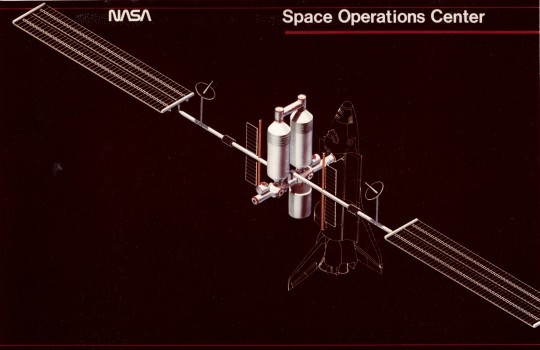

"The SOC is a self-contained orbital facility built up of several Shuttle-launched modules. With resupply, on-orbit refurbish- ment and orbit maintenance, it is capable of continuous operation for an indefinite period. In the nominal operational mode, the SOC is manned continuously, but unmanned operation is possible.

The present mission management and control process is characterized by a people-intensive ground monitoring and control operation involving large supporting ground information and control facilities and a highly- integrated ground-flight crew operation. In order to reduce dependence on Earth monitoring and control, the SOC would have to provide for increased systems monitoring; fault isolation and failure analysis, and the ability to store and call up extensive sets of data to support the onboard control of the vehicle; and the onboard capability for daily mission and other activity planning."
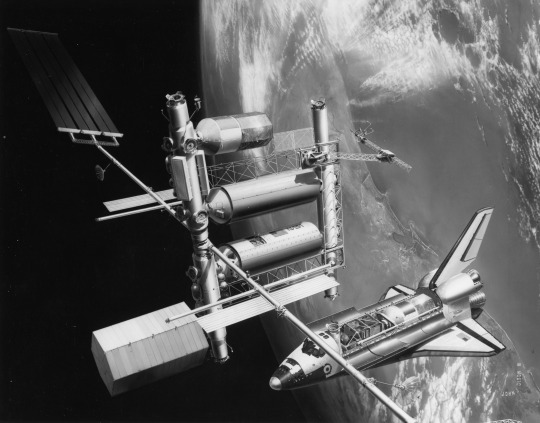

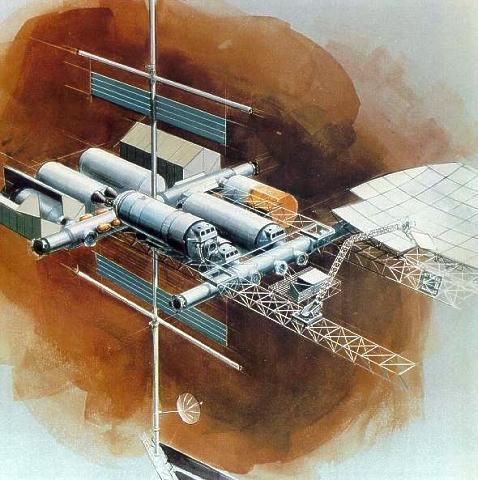
"Like most other space station studies from the mid/late 1970s its primary mission was the assembly and servicing of large spacecraft in Earth orbit -- not science. NASA/JSC signed a contract with Boeing in 1980 to further develop the design. Like most NASA space station plans, SOC would be assembled in orbit from modules launched on the Space Shuttle. The crew's tour of duty would have been 90 days. NASA originally estimated the total cost to be $2.7 billion, but the estimated cost had increased to $4.7 billion by 1981. SOC would have been operational by 1990.
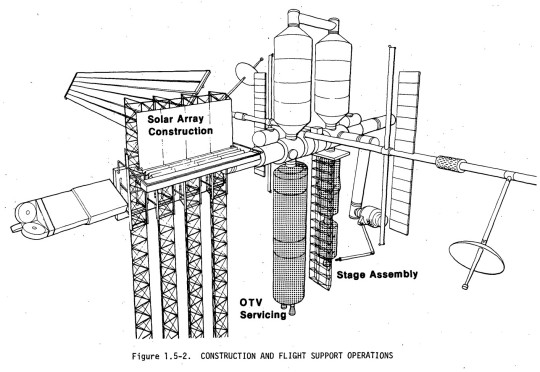
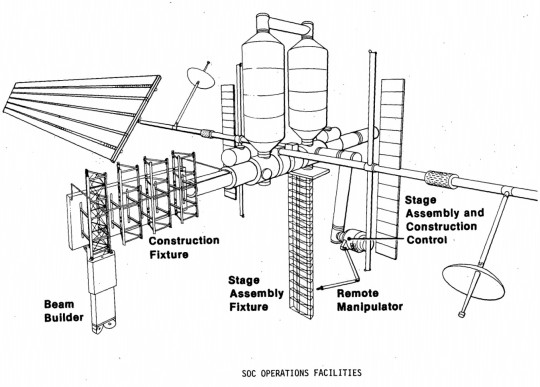

NASA's Johnson Spaceflight Center extended the Boeing contract in February 1982 to study a cheaper, modular, evolutionary approach to assembling the Space Operations Center. An initial power module would consist of solar arrays and radiators. The next launches would have delivered a space tug 'garage', two pressurized crew modules and a logistics module. The completed Space Operations Center also would have contained a satellite servicing and assembly facility and several laboratory modules. Even with this revised approach, however, the cost of the SOC program had grown to $9 billion. Another problem was Space Operations Center's primary mission: spacecraft assembly and servicing. The likely users (commercial satellite operators and telecommunications companies) were not really interested in the kind of large geostationary space platforms proposed by NASA. By 1983, the only enthusiastic users for NASA's space station plans were scientists working in the fields of microgravity research and life sciences. Their needs would dictate future space station design although NASA's 1984 station plans did incorporate a SOC-type spacecraft servicing facility as well."
Article by Marcus Lindroos, from astronautix.com: link




NASA ID: link, S79-10137
Boeing photo no. R-1859, link, link
#Space Operations Center#Space Station Freedom#Space Station Concept#Space Station#Concept Art#Space Station Program#Space#Earth#Space Shuttle#Orbiter#NASA#Space Shuttle Program#1979#1980s#my post
455 notes
·
View notes
Text
The US and Europe can no longer compete with China after the cost of producing solar modules there dropped by 42% in 2023 to $0.15 (€0.14) per watt. That gives Chinese manufacturers an enormous cost advantage over international rivals, according to a new Horizons report from consultancy Wood Mackenzie.
In 2023, China's domestic solar additions were double those of the US and the EU combined. China, the world's solar module powerhouse, now holds 80% of global manufacturing capacity. By 2050, it will account for over 50% of the global power supply, according to Wood Mackenzie.
"China is the lowest-cost solar module manufacturer in the world. Solar module prices in dollar per watt tallied in December show China's cost of $0.15 well below Indian ($0.22), European ($0.30) and US ($0.40) manufacturing rates," said Steven Knell, vice president and head of Power & Renewables Consulting, EMEA, at Wood Mackenzie.
"The enormous cost advantage China holds imply international rivals' efforts to displace incumbent Chinese suppliers in renewable value chains may well be futile. The outlook for available component supply in the market is bullish given the capacity race that's underway, but China's rivals are unlikely to win on cost. China's already won the green technology capacity race," Knell told DW.[...]
The EU and US have made huge strides in renewable energy policy in the past two years. But reaching critical mass in the solar module production sector, like in China, requires commensurate commercial application, the experts agree. And this is where centralized state capitalism [sic] seems to offer certain advantages.
1 Jan 24
82 notes
·
View notes
Text

New SpaceTime out Friday
SpaceTime 20240913 Series 27 Episode 111
Evidence of Unexpected Population of Kuiper Belt Objects
A new study has detected an unexpected population of very distant bodies in the Kuiper Belt, an outer region of the solar system populated by ancient remnants of planetary building blocks lying beyond the orbit of Neptune.







The Martian polar caps are not created equally
A new study has confirmed that the Martian polar ice caps are evolving very differently from each other.










Artemis III service module on its way to NASA
The European Space Agency’s Artemis III service module destined for use on the historic mission that will return humans to the lunar surface in 2026 is about to commence its journey to the Kennedy Space Center.









The Science Report
Bird flu now spreading on Antarctica’s South Georgia island and the Falkland Islands.
Finding New Zealand’s original native animals.
Australian HIV levels continue to drop.
SpaceTime covers the latest news in astronomy & space sciences.
The show is available every Monday, Wednesday and Friday through Apple Podcasts (itunes), Stitcher, Google Podcast, Pocketcasts, SoundCloud, Bitez.com, YouTube, your favourite podcast download provider, and from www.spacetimewithstuartgary.com
SpaceTime is also broadcast through the National Science Foundation on Science Zone Radio and on both i-heart Radio and Tune-In Radio.
SpaceTime daily news blog: http://spacetimewithstuartgary.tumblr.com/
SpaceTime facebook: www.facebook.com/spacetimewithstuartgary
SpaceTime Instagram @spacetimewithstuartgary
SpaceTime twitter feed @stuartgary
SpaceTime YouTube: @SpaceTimewithStuartGary
SpaceTime -- A brief history
SpaceTime is Australia’s most popular and respected astronomy and space science news program – averaging over two million downloads every year. We’re also number five in the United States. The show reports on the latest stories and discoveries making news in astronomy, space flight, and science. SpaceTime features weekly interviews with leading Australian scientists about their research. The show began life in 1995 as ‘StarStuff’ on the Australian Broadcasting Corporation’s (ABC) NewsRadio network. Award winning investigative reporter Stuart Gary created the program during more than fifteen years as NewsRadio’s evening anchor and Science Editor. Gary’s always loved science. He studied astronomy at university and was invited to undertake a PHD in astrophysics, but instead focused on his career in journalism and radio broadcasting. Gary’s radio career stretches back some 34 years including 26 at the ABC. He worked as an announcer and music DJ in commercial radio, before becoming a journalist and eventually joining ABC News and Current Affairs. He was part of the team that set up ABC NewsRadio and became one of its first on air presenters. When asked to put his science background to use, Gary developed StarStuff which he wrote, produced and hosted, consistently achieving 9 per cent of the national Australian radio audience based on the ABC’s Nielsen ratings survey figures for the five major Australian metro markets: Sydney, Melbourne, Brisbane, Adelaide, and Perth. The StarStuff podcast was published on line by ABC Science -- achieving over 1.3 million downloads annually. However, after some 20 years, the show finally wrapped up in December 2015 following ABC funding cuts, and a redirection of available finances to increase sports and horse racing coverage. Rather than continue with the ABC, Gary resigned so that he could keep the show going independently. StarStuff was rebranded as “SpaceTime”, with the first episode being broadcast in February 2016. Over the years, SpaceTime has grown, more than doubling its former ABC audience numbers and expanding to include new segments such as the Science Report -- which provides a wrap of general science news, weekly skeptical science features, special reports looking at the latest computer and technology news, and Skywatch – which provides a monthly guide to the night skies. The show is published three times weekly (every Monday, Wednesday and Friday) and available from the United States National Science Foundation on Science Zone Radio, and through both i-heart Radio and Tune-In Radio.
#science#space#astronomy#physics#news#nasa#astrophysics#esa#spacetimewithstuartgary#starstuff#spacetime#jwst#hubble space telescope
10 notes
·
View notes
Text
Unfinished Timeline for an Untitled Setting
Critique and advice is more than welcome, though please be nice about it. Goes up to about 2081 rn, though I plan to get at least another 50 years further in before I get to the time I want the bulk of the setting to be set in.
Timeline:
2022: First controlled break-even fusion reaction, followed by first controlled net-gain fusion reaction.
2025-2026: Increasing unrest in USA leads to mass riots outside the white-house. Sweeping reforms after growing revolts threaten to become a major armed rebellion. NASA miraculously left untouched, general increase in standard of living. Economic crisis narrowly averted.
2027: First nuclear thermal rocket (NTR) tested in orbit by NASA and DARPA. GPT-style language modeling declared “dead end” for self-aware AI.
2030: First Lunar base established under NASA Artemis program. Suez Canal temporarily blocked by a poorly driven cargo ship again. Evergreen Shipping goes bankrupt.
2034: Lunar Gateway established under joint NASA, ESA, JAXA, DLR, ASI, and CNSA. Lunar helium-3 mining declared officially nonviable. Radial detonation engines become standard for lower ascent stages, SpaceX Starship, NASA SLS, and Roscosmos Soyuz phased out. Drop in launch prices.
2034-2036: Additional modules added to the Lunar Gateway from SpaceX, KARI, ISRO, and Roscosmos. Lunar Gateway Collaborative Group (LGCG) established consisting of all current contributors to the station.
2036: First commercial fusion energy plant reaches full operation in France under ITER. Mass production of Tritium begins. First fully private space station under SpaceX. Asteroid mining corporations begin formation. Establishment of Nigerian Organization for the Development of Space (NODS). Ecuador experiences communist revolution.
2036-2037: First manned martian mission under LGCG, first human footsteps on another planetary body.
2037: Elon Musk assassinated. New SpaceX leadership declares plans for space elevator. North Korea collapses, Korean peninsula unified under South Korean leadership, becoming simply Korea. Indian nuclear stockpile secretly surpasses 50000 Gt. First baby born on the moon.
2040: Artemis base becomes semi-self sufficient, producing it’s own food and air from hydroponics, and water from mined lunar ice. Lunar LH2 and hydrolox production begins. Lunar population passes 100.
2040-2042: First commercial fusion power plants established in the US, UK, Australia, Korea, and Japan.
2042: A joint US Government and SpaceX black operation destabilizes Ecuador, leading to a corporate takeover of the territory.
2044: Korea, Japan, the Philippines, Vietnam, Malaysia, Indonesia, Papua New Guinea, Australia, and New Zealand form West Pacific Trade Organization (WPTO). Construction of the base of SpaceX’s planned space elevator begins off the coast of Ecuador.
2047: LCC completed at CERN. Mission for permanent martian base declared. Major economic crisis in China, intervention from several megacorps results in a decrease in Chinese government power and increase in corporate control in the region. SpaceX space elevator counterweight construction begins in geostationary orbit.
2048: Major revolution in quantum mechanics brought on by new data from the LCC. Lunar population passes 250.
2050: China splits into 4 corporate states, Amazon Corporate Territory (ACT) with its capitol in Chongqing, Samsung Independent State (SIS) with its capitol in Shanghai, Territory for Electronic Developments (TED) made up of Apple and Microsoft with its capitol in Yinchuan, and the Chinese Corporate Union (CCU) made up of several formerly state-owned corporations with their capitol in Wuhan and possession of the Three Gorges Dam. Beijing becomes an independent city-state controlled by the former Chinese government, retaining control over the CNSA. Massive revolution in battery energy density. Permanent martian base established by LGCG.
2051: Breakthrough in photon manipulation, beamed energy and solar collection becomes increasingly viable. Many asteroid mining corps branch into solar power, notably Binghamton Vacuum Mining Solutions (BVMS). Lunar population passes 500.
2052: Martian population surpasses 100.
2053: Martian base reaches semi-self sustainability.
2055: All 4 Chinese corporate states and the Beijing city state form the Chinese Federation for Space Exploration (CFSE), supplanting the old CNSA. Lunar Gateway module renamed and LGCG roster amended accordingly. SpaceX space elevator cable completed, first test cart sent to GEO. WPTO begins construction of a space elevator in the Banda Sea.
2056: SpaceX space elevator declared complete, commercial operation begins.
2057: BVMS surpasses $1T in net worth, becomes primary supplier of energy for the Artemis Lunar Base. Lunar Population surpasses 1k, massive migratory population surge begins following influx of energy from BVMS. Martian population surpasses 250. First fusion reactor in Ecuador.
2058: WPTO space elevator counterweight begins construction in GEO.
2060: First fusion reactors in Nigeria and India. First large-scale solar collector on Earth constructed in New York operated by BVMS. Large population surge in Binghamton NY. Lunar population surpasses 5k. Martian space station established. Regulations for GEO development established.
2061: First lunar-built spacecraft flown. Secondary lunar settlement founded by CFSE. Massive influx of funds for the WPTO space elevator from the CFSE, GEO counterweight construction begun. Lunar Gateway population surpasses 100. First fusion reactor in the Democratic Republic of the Congo (DRC), Congo space agency (DRCSA) founded.
2064: WPTO space elevator cable completed, declared complete and opened to commercial operation.
2065: BVME establishes unmanned Mercurian base. CFSE settlement population surpasses 100. Martian population surpasses 500. Lunar Gateway population surpasses 200.
2066: Mass expansion of Artemis Base life support systems using BVMS produced automated construction equipment. Aerostat scientific outpost established by LGCG.
2067: Microbial life discovered on Venus. Venus outpost (and LGCG) acquires substantial funding boost. Artemis base population surpasses 2.5k and begins to plateau.
2069: Unmanned mission to Europa announced by LGCG, plans to use BVMS automated platforms to drill into subsurface ocean established. Martian base purchases automated construction equipment from BVMS, massive population boon ensues. CFSE settlement population surpasses 750. Lunar gateway population surpasses 500. Martian base population surpasses 500. BVME becomes the largest corporate entity in the system.
2070: BVMS performs feasibility study on gas giant aerostat mining platforms.
2071: Study of Venusian lifeforms disproves Earth-Venus panspermia.
2073: BVMS tests laser-sail propulsion on small unmanned craft.
2075: LGCG Europa mission discovers multicellular aquatic life in Europa’s subsurface ocean. Plans for a dedicated research base drafted.
2076: Multi-corporate base established on Ceres to facilitate further asteroid belt mining. BVMS intentionally excluded from this project.
(System effectively split into quarters: Past Venus under BVMS, Between Venus and Mars under LGCG, belt under Multi-corporate mining control, outer system unclaimed.)
2077: GEO-Lunar cycler niche mostly filled by Intraplanetary Transport Services corp (ITS).
2080: Permanent scientific base established at the Europa Breach Point (EBP) with mostly automated systems and a small (5 human) management and maintenance crew.
2081: Panspermia further disproved by study of Europan life. Massive object detected in Jupiter’s lower atmosphere. BVMS begins mission to establish a mining aerostat on Saturn, utilizing laser sail propulsion to transport equipment.
(Saturn Aerostat site intended for use in the further colonization of the outer solar system and the Uranus planetary system itself. Atomic Rockets page)
12 notes
·
View notes
Text
Our Rooftop Solar Plant Services Harness the Sunshine
Every business should understand the importance of transitioning to solar power. Utilizing the sun’s rays for electricity production is an eco-friendly approach, marking a crucial step towards sustainability.
Solid Solar ensures that your move to solar electricity is both ecologically responsible and financially beneficial. We significantly lower your electricity expenses by installing rooftop solar plants while also delivering creative structural designs that are adapted to your specific demands.

Our professional installation services guarantee optimal performance and a clean finish. Rooftop solar power systems consist of photovoltaic modules, mounting systems, cables, inverters, and other electrical components, seamlessly integrated into your building’s roof.
Here are some key benefits of rooftop solar power systems:
Reduced Electricity Bills: Solar panels convert sunlight into electricity, significantly reducing ongoing electricity expenses. It’s a one-time investment with long-term benefits.
Space Efficiency: With rooftop installations, there’s no need for additional space allocation. The panels are strategically placed on your existing building structure, maximizing efficiency without compromising space.
Environmental Impact: Solar energy production minimizes environmental pollution compared to conventional energy sources. Solar panels operate silently and emit fewer harmful gases, reducing carbon footprints and promoting cleaner air.
Government Support: Government initiatives incentivize the adoption of solar energy. Tax credits and subsidies are offered to both residential and commercial installations, making solar power an economically viable choice. According to the Ministry of New and Renewable Energy, the government provides a 30% subsidy on installation costs.
At Solid Solar, we provide the best rooftop solar solutions, ensuring optimal returns on your investment. You can contact us at +91 82879 04423 for more information. We look forward to hearing from you. Join us in embracing a sustainable future powered by the sun.
2 notes
·
View notes
Link
Perovskite solar cells (PVSCs) are a promising alternative to traditional silicon-based solar cells because of their high power-conversion efficiency and low cost. However, one of the major challenges in their development has been achieving long-term stability. Recently, a research team from City University of Hong Kong (CityU) made a breakthrough by developing an innovative multifunctional and non-volatile additive which can improve the efficiency and stability of perovskite solar cells by modulating perovskite film growth. This simple and effective strategy has great potential for facilitating the commercialisation of PVSCs.
"This type of multifunctional additive can be generally used to make different perovskite compositions for fabricating highly efficient and stable perovskite solar cells. The high-quality perovskite films will enable the upscaling of large-area solar panels," explained Professor Alex Jen Kwan-yue, Lee Shau Kee Chair Professor of Materials Science and Director of the Hong Kong Institute for Clean Energy at CityU, who led the study.
PVSCs have attracted significant attention due to their impressive solar power conversion efficiency (PCE). Since perovskites can be deposited from solutions onto the fabrication surfaces, PVSCs have the potential to be applied in building-integrated photovoltaics (BIPV), wearable devices, and solar farm applications. However, the efficiency and stability are still affected by the severe energy loss associated with defects embedded at the interfaces and grain boundaries of the perovskites. Therefore, the intrinsic quality of perovskite film plays a critical role in determining the achievable efficiency and stability of PVSCs.
Read more.
#Materials Science#Science#Perovskites#Solar power#Materials processing#Molecules#Hydrogen#Hydrogen bonding
7 notes
·
View notes
Text
Where Are They Now - MTVs
With the introduction of the latest plan from NASA and the Olympus Partners to pursue not only a Martian program, but a Lunar one, it was ultimately deemed necessary to ensure that a new generation of Mars Transfer Vehicles continued to power crews out to the Red Planet without sacrificing capabilities. While the original nuclear thermal design had proved to be highly advantageous for the program, there were elements in which the design struggled - notably crew capacity and lack of full reuse characteristics. In 2020, a group at Marshall Space Flight Center, the very same birthplace of the first generation MTV, would gather to begin to design the next generation of spacecraft. Initial designs called for something referred to as the Deep Space Transport, or DST, highlighting the multi-mission nature of the vehicles, and centered much of their focus around a fully solar electric architecture using a large, rigid “workshop” module. Ultimately, this configuration would end up with intense power draw requirements and longer trip times, something that mission planners wanted to avoid in order to ensure maximum science return on the Red Planet itself. The next option explored would be a hybrid of sorts, a massive methalox chemical stage, supplemented by a nuclear powered VASIMIR thruster. These twin propulsion systems would work together for various phases of flight, with the Nuclear-Electric element doing the outward push, and the chemical stage performing the arrival burn at both Mars and departure from when the time came. Post arrival, the electric stage would ignite once more to slowly spiral down to the Low Martian Orbit customary of Olympus operations, where the vehicle would rendezvous with the Base Station and MADV for the sortie to the Martian Surface.

Endurance conducts her first test of the new VASIMIR system, fed by a powerful nuclear reactor.
In December 2027, after a long and arduous design period, the first launch of the newly named Armstrong Class MTV Endurance would be conducted by Jupiter-OPAV, carrying the largest single element - the chemical transfer stage. This would see Adventure pushed to her absolute limits, having recently completed her Block III upgrades. After a flawless flight to orbit, the great chemical stage would separate and coast free, with the OPAV pod returning to land in the California desert. Over 7 additional launches, the inflatable habitat, workshop, node and truss segments would be launched to the growing vehicle. In March of 2028, she would be visited by the crew of ACEV Kitty Hawk for checkout once the reactor had been delivered, configuring her for her service life. She was an impressive vehicle, with MTV Endurance acting not only as a fully functional Mars Transfer Vehicle, but a testbed for technologies needed to augment future human spaceflight endeavors. Her first crew would marvel at her size, and conduct final bolt tightening and maintenance work before her series of practice burns over the next few months, simulating various maneuvers. With a successful electric thruster demonstration under her belt, she would be topped up by a series of new, commercially and internationally launched methane tankers In June of 2028, Endurance would receive her crew onboard ACEV Columbia, having launched only 12 hours prior onboard an Atlas EvO. Their international crew consisted of members who had only been children when the first rotations to the Red Planet had begun, finally fulfilling their dream of walking on worlds unknown. Olympus 19 would cast off from planet Earth only 8 days after their arrival, conducting a 6 month voyage to Mars to further research at Foundation. Soon, Endurance’s sister ships would be brought online one by one, Constellation and Pathfinder - to continue the dream of human exploration of Mars. This dramatic capability increase would also see the need arise for a second MADV, to support larger crews operating around Mars. Enterprise’s sister ship, Phoenix, would be launched to Low Martian Orbit to support crews of up to 16 at Foundation as the complex expanded dramatically.

Endurance waits patiently in orbit for her maiden voyage, a gargantuan undertaking finally complete - ready to power the future of human endeavors in spaceflight.
Minerva herself had already been modified in support of Destiny, removing her drop tank mounting points and habitation section, with those components being returned to LEO for servicing and potential conversion. What remained of her now was the core fuel tanks, solar arrays, a cargo mounting point for the Altair Common Lunar Lander, and her avionics ring. To spaceflight enthusiasts, she was a shell of her former self, but in the eyes of the Mission Planning Office, she was right where they needed her to be. An international crew of 6, commanded by Olympus 15 veteran Lance Novak would set off from Earth in August 2027, launching onboard ACEV Columbia for the short journey to the Moon. Minerva would brake into an elliptical orbit, high above the gravitational anomalies that limited Apollo’s stay in lunar orbit. On August 28th, 2027, the crew of Destiny III would board their lander, Artemis, and make the descent to the Lunar surface, aiming for the rim of Shackleton Base. Their lander, a joint project between NASA, ESA and JAXA locked on to the Russian built beacon already in place onboard their cargo lander, and soon the crew of 6 could begin their initial operations, setting up a permanent, rapidly expandable base on the Lunar surface. Prometheus and Selene would soon see retirement from Martian sorties as the Armstrong Class ramped up their operational cadence. They would spend their golden years here, servicing the Earth-Moon system as they ferried crews, cargo and more between the growing base at Shackleton, supporting crucial operations as the population of the moon rapidly grew through the 2030s. Soon, the needs of the growing base would surpass that of the original MTVs, and the great ships would be broken up in Lunar orbit, with usable components brought down to the surface to expand the growing base. Tanks would be repurposed for hydrogen storage, vital in support of the growing demands of fuel production. The MTVs would find themselves living out their days incorporated into human architectures, spread out across the lunar surface. Well, nearly all of them.
Hera’s time in service ended long before her sisters. Due to the damage sustained by Chris Taylor’s impact along with the structural failure of the robot arm, the helium coolant circuit and one of the redundant ammonia circuits were emptied long before her arrival at the world of her birth. Through the careful management of propellant and power, flight controllers were able to keep her alive all the way back to Earth. In the absence of coolant, bled off into the vacuum of space, the Valkyrie engines had their control drums locked in the neutral position and had the xenon quench fired shortly before entering the Earth-Moon system to ensure the reactors would never start again. Hera had built up too much energy during the abort to be captured at earth. She would be forced to leave her crew behind as she threw herself past their home. The final act of her propulsion system would be supporting the safe separation of the Lifeboat, burning the last of the hydrazine propellant, the last drops of her blood, to increase separation from her precious crew and give them the best odds of making it home. NASA had good reason to believe heliocentric space would become much busier in the future, and since she could not be tracked on her solo trek around the sun, Hera was made to pose as little of a hazard as possible. Hera had mostly been bled dry but as a final precaution, all her propellant tanks were opened to vacuum to minimize the risk of a breakup. One by one her batteries were discharged and isolated from the solar panels to prevent their explosion. The team behind each subsystem said their goodbyes as their respective computer, pump, or gyroscope was turned off for the final time. The final command sent was to turn off the remaining CMG and broadcast the abort repeater tone indefinitely. The message ended with a text string to be read by no one. “Thank you Hera. Rest well” Back on Earth, Hera’s lifeboat was placed on display in an annex built onto building 30 at JSC. New flight controllers are brought into the room on their third day of training where the audio recorded onboard Hera during the abort is played back, a reminder of painful day's past. The intent is to not only remind them of the stakes of the job but demonstrate that they will never run out of options in their fight to bring a crew home safe. Hera herself orbits silently between earth and Venus. Over many years a tumble slowly developed from the uneven pressure exerted on the two remaining radiators and the reflective MLI on her tanks. Despite this - she remained intact and never experienced a close encounter with any planet again. She remains the only original Olympus hardware that is left unperturbed or unmodified, free to silently observe humanity's future in the solar system.
Photos by Jay
Additional Writing by Posstronaut Peter
Read Proxima here
#alt history#alternate history#proxima: a human exploration of mars#proxima#space#space travel#space exploration#alternate future#mars transfer vehicle#future tech#technology#worldbuilding
13 notes
·
View notes
Text
Lithium Ion Battery Products of Eco Power
Eco Power Group is more than a lithium battery company. We design, manufactures, and sell advanced lithium-ion energy storage electrification solutions for different types of lithium ion battery.
Our expertise of custom lithium ion battery is based on its know-how in electrochemistry and battery management system to provide safe, efficient and sustainable solutions to various industries such as automotive, commercial transportation, off-highway vehicles/equipment, rail, air, marine, energy storage, solar energy systems, communication equipement, and more.
We are your experienced partner of lithium ion battery wholesale, from the feasibility study to the conception and the final installation with our complete product portfolio.
If you are considering to buy lithium ion battery, we are highly welcome you to consult and cooperate with us.
Different Types of Lithium Ion Battery Products
On-board energy solution at Eco Power Group with complete reference from cell to system to be the best fitting solution for your lithium ion battery types.
Battery Cell
This type of custom lithium ion battery cell is the very basic energy storage unit. Based on many years experience from cell design, battery materials and simulation, we are always at the cutting edge of technology. Our li ion batteries for sale comply with the strict safety standards UN 38.3, which guarantees our customers high quality and safety even after years of operation of charging lithium ion batteries.
Battery Module
In terms of battery modules for different types of lithium ion battery, there we offer standard modules with metal sheet plate for electric vehicle applications, Custom lithium ion battery module with binding tape for energy storage, and VDA size modules for passenger vehicles.
Battery Pack
Standard battery packs for commercial vehicles. Standard battery packs of charging lithium ion batteries in series with DNV certification for marine propulsion. Customized power li ion charging voltage systems for forklift applications ,etc.
Battery Energy Storage System
With a team of experienced engineers, we provide end to end custom lithium ion battery services starting from customer requirement analysis going through battery pack design, testing, prototype production and serial production. During the design phase we focus on the application area requirements as much as the li ion charging voltage battery design itself.
Why Choose The Lithium Ion Battery From Eco Power?
Quality
Our established quality management system of lithium ion battery wholesale, certified according to the international standard DIN EN ISO 9001: 2008, guarantees compliance with our high quality standards.
01
Customised Solution
Customised solutions for lithium ion battery replacement energy storage or mobile applications of electromobility.
02
Experience
As one of the leading lithium ion battery companies, we have more than 10years experience in lithium li ion voltage battery industry with hundreds of different application scenario. With our high quality lithium ion batteries for sale, you can trust us with your project .
03
Technical Support
From customer request input all the way to delivery final different types of lithium ion battery product, we will assign project technical consultant to accompany our customer to solve all of li ion charging voltage questions or problems during the whole process.
04
What Does A Lithium Ion Battery Module Do?
Battery module of li ion batteries for sale contains the energy storing battery cells by laser-welded technology, the mechanically stable against shock demonstrates high productivity and flexibility to make sure the long term performance of li ion charging voltage battery system.
How A Lithium Ion Battery System Works?
A battery system of li ion charging voltage consists of lithium battery cell connected in series to reach the system voltage and parallel to achieve greater capacity.
The li ion battery voltage and capacity can be verified by different combination of packs. The pack contains a fuse and a slave BMS. High security and provide lithium ion cell voltage and temperature to master BMS.
The Lithium-Ion battery system with charging lithium ion batteries in parallel is a composite set of battery electronics, high voltage circuits, overcurrent protection devices, battery boxes and interfaces with other external systems such as cooling, high voltage, auxiliary low voltage and communications.
What Is The Difference Between Lithium Ion Battery Pack And Power Bank?
This kind of battery pack of lithium ion battery types cannot be a power bank, but a power bank can be a li ion battery charging voltage pack with added electronic circuitry to prevent over charging, over discharge, etc to protect the batteries.
A lithium ion battery pack in series is merely a bunch of batteries connected in Series/Parallel configuration with one positive and one negative terminal.
A power bank contains one or more batteries in mostly parallel but could also be a Series/Parallel configuration. These types of li ion batteries for sale are connected to a battery management circuit (module) which controls the charging of the batteries. All this is housed in a compact enclosure.

2 notes
·
View notes
Text
The Benefits and Advantages of Installing JA Solar Panels in Your Home or Business

JA Solar is one of the world's largest manufacturers of solar panels. The company produces both monocrystalline and polycrystalline silicon solar cells and modules. JA Solar has a strong international presence, with manufacturing facilities in China, Malaysia, and South Africa. The company also has offices in the United States, Europe, Australia, Japan, and India. JA Solar's products are used in a variety of applications, including residential, commercial, and utility-scale solar power plants.
https://www.chemitechgroup.com/ja-solar-panel-distributors-india/
2 notes
·
View notes
Text
BIPV Market: Trends Supplement Large-Scale Solar Systems Adoption
As per the International Energy Outlook, the global power demand is expected to rise by 80%, requiring an investment of around $19.7 trillion by 2040. Also, the Paris Agreement set a target of limiting global warming temperature below 2° Celsius, preferably 1.5° Celsius. This has influenced governments to seek innovative ways to reduce emissions while meeting energy demand, which has paved the way for photovoltaic materials in buildings. Triton’s analysis estimates that the global building integrated photovoltaics market will propel at a CAGR of 17.31% during the forecast period 2023-2030.
Building integrated photovoltaics serves the dual purpose of being the outer layer of a building and a power generator. This, in turn, has opened a new frontier in green infrastructure, influencing architects to develop energy-efficient and aesthetically appealing buildings. For instance, Ubiquitous Energy’s transparent solar window panels, UE Power, have emerged as an aesthetically appealing power-generating alternative to conventional windows.
BIPV Revolution: Trends Reshape Energy Landscape
According to the International Renewable Energy Agency (IRENA) , around 90% of the world’s power can be generated with renewable energy by 2050. Since buildings consume high amounts of energy, BIPV integration will facilitate their transition from energy users to producers. On that note, the notable trends reshaping the market are:
Governments perceive investing in green energy solutions as an opportunity to attain GHG reduction targets. Hence, over the past few years, authorities worldwide have employed various measures to stimulate the adoption of sustainable technologies, including BIPV modules, across residential, commercial, and industrial sectors. For example:
As per the Indian Ministry of New & Renewable Energy (MNRE) , the government has implemented the production-linked incentive (PLI) scheme for high-efficiency solar PV modules with an outlay of INR 24,000 crore, to achieve domestic manufacturing capacity of solar PV cells and modules.
In 2021, the German government amended the Renewable Energy Act by establishing grid priority to drive the onshore wind, solar PV, and biogas growth. The government proposed to increase its solar capacity installations to 100 GW by 2030.
The Chinese government also formulated a policy that requires all new buildings to conform to energy guidelines modeled after LEED specifications. This policy combines a recent initiative to reconstruct 50% of residential high-rise buildings. The country is anticipated to add more than 600 GW of solar power by 2030.
Reaping the benefits from such incentives, the industrial sector leads the BIPV market at 39.54%. However, over the forecast period 2023-2030, the commercial sector is expected to witness the fastest growth at 17.38%.
As per IEA, the global solar PV generation reached around 821 TWh in 2020, a whopping 23% increase from 2019. The energy association also stated that next to utility-scale deployment, distributed applications on buildings contribute to around 40% of PV use globally. In this regard, rooftop-based applications are alleviating the burden on the distribution grids, enabling companies and households to pay lesser energy bills while reducing emissions. Moreover, the cost of installing rooftop PV systems reached around $1 per watt. Hence, roofing captures the majority of the market share at 55.69% in terms of application.
China drives the global market, followed by the US, European nations, and Japan playing a major role. The rise in installations from around 19.4 GW in 2017 to 27.3 GW in 2021 was the key aspect that made China a leader in rooftop installations. For instance, Shanghai and Dezhou have acquired the title of ‘Solar City’, which features a large fleet of rooftop solar water heaters. Besides, the Net Zero Energy Building mandate across China is expected to accelerate the PV roofing segment, with solar tiles gaining major traction. Hence, these developments are expected to widen the scope of the Asia-Pacific BIPV market over the forecast period 2023-2030.
IEA projects that photovoltaic systems are estimated to account for approximately 14% of the total power generation by 2050, owing to the rising detrimental impact of fossil fuels. In fact, the organization stated that PV systems saved more than 860 million tons of C02 in 2020. The construction industry is highly innovative in the commercial sector owing to the development of cost-effective zero-emission green facilities.
As per IRENA, Germany ranks fourth in solar energy production globally. In 2021, the nation installed solar capacities of almost 60 GW, an increase of 5.3 GW from 2020. These actions are based on the country’s aim to obtain a 65% share of the renewable energy sector by 2030. Moreover, the Energy Efficiency Strategy for Building suggested advanced technology development to achieve the goal of a virtually climate-neutral building stock by 2050. Hence, the growing focus on sustainable energy sources fuels the overall Europe BIPV market, spearheaded mainly by Germany.
PV Cost Reduction: A Driving Force for Market Players
Since photovoltaic systems generate energy with around 42% efficiency using multi-junction cells, they have emerged as an ideal alternative over complex installations, such as wind turbines. As per the UN, between 2010 to 2020, the cost of power from solar systems plummeted by around 85%. This highlights the question:
What induced PV cost reduction?
The significant cost decline is mainly because of overproduction and higher investment in PV modules. Another factor is the efforts by Chinese suppliers and wholesalers to reduce the stock held in European warehouses to prevent anti-dumping and anti-subsidy tariffs. This oversupply, from China to Europe thus shrunk the cost of silicon. Such developments led energy solutions supplier Sungrow to supply products to the world’s largest BIPV plant (120 MW) in Central China’s Jiangxi Province. Therefore, the increasing efficiency, ease of installation, and decreasing cost of PV modules over conventional sources like coal and natural gas are expected to open new avenues for players in the building integrated photovoltaics market.
#building integrated photovoltaics market#bipv market#bipv#energy industry#power industry#market research report#market research reports#triton market research
2 notes
·
View notes
Text
The Europe Solar Inverter Market: Trends, Forecasts, and Key Insights
The solar inverter market in Europe is experiencing notable growth and transformation. As of 2024, the market size is estimated to be USD 2.85 billion and is anticipated to reach USD 3.66 billion by 2029, driven by a Compound Annual Growth Rate (CAGR) of 5.06% during the forecast period from 2024 to 2029.
Market Overview and Growth Drivers
According to Mordor Intelligence, the growth of the European solar inverter market can be attributed to several key factors. Supportive government initiatives and substantial investments in electrification through solar energy are expected to play a significant role in this expansion. As Europe continues to prioritize renewable energy, these initiatives are expected to drive demand for solar inverters, which are crucial for converting solar energy into usable electricity.
However, challenges remain. The lack of general awareness, high infrastructure development costs, and recent subsidy cuts on solar panels by European governments pose potential barriers to market growth. Despite these obstacles, the market is expected to thrive as inverter manufacturers push for technological innovations and advancements.
Technological Trends: Central Inverters to Dominate
Central inverters are projected to dominate the European solar inverter market during the forecast period. These inverters, which are typically used in large-scale solar photovoltaic systems with rated outputs exceeding 100 kWp, convert direct current (DC) power from solar arrays into alternating current (AC) for grid connection.
Central inverters range in capacity from around 50 kW to 1 MW and can be utilized both indoors and outdoors. They generally feature a single DC-AC conversion stage, though some include a DC-DC boost stage to enhance the Maximum Power Point (MPP) voltage range. Advances in central inverter technology, such as higher input voltages of up to 1,500V, are expected to further boost their market dominance.
Noteworthy projects, like the 154 MW Ratesti PV plant in Romania by Sungrow, underscore the increasing adoption of central inverters. This project aims to significantly contribute to energy transition and independence in Southeast Europe by generating substantial amounts of clean energy.
Germany: The Market Leader
Germany is anticipated to be the largest and fastest-growing market for solar inverters in Europe. The country’s leadership in solar photovoltaic (PV) installations is supported by favorable policies, such as feed-in tariffs and incentives for medium- to large-scale commercial systems. In 2023, Germany was expected to lead the EU solar market with significant annual and total installations.
The Renewable Energy Act of 2021 and various auction results have further solidified Germany’s position in the solar PV market. The increasing installation capacity, coupled with reduced costs of solar PV modules and energy storage systems, is expected to drive the solar inverter market in Germany.
Competitive Landscape
The European solar inverter market is highly fragmented, with key players including:
Schneider Electric SE
Siemens AG
FIMER SpA
Mitsubishi Electric Corporation
General Electric Company
These companies are at the forefront of technological advancements and market developments, contributing to the dynamic nature of the market.
Recent Developments
Recent news highlights the ongoing innovation in the sector. For example, SMA Solar Technology AG’s plan to build a new gigawatt solar inverter manufacturing facility in Germany is set to double its production capacity. Additionally, new product launches, such as SMA’s Sunny Tripower-X models, reflect the industry’s focus on enhancing inverter performance and grid compliance.
Conclusion
The European solar inverter market is on an upward trajectory, driven by technological innovations, supportive policies, and significant investments in renewable energy. Despite challenges, the market is set to grow substantially, with Germany leading the charge. For a comprehensive analysis of the European solar inverter market, including detailed forecasts and insights, refer to the latest report by Mordor Intelligence.
#European solar inverter market#European solar inverter market share#European solar inverter market size#European solar inverter market trends
0 notes
Text

SOLAR AFRICA Only one day left to #SolarTanzania! 🚀 We can’t wait to see you in Dar es Salaam on 25-27 September 2024! 🌍 Visit our booth B160 to learn about the game-changing energy solutions we have in store for you!
Here are the latest tech we’ll be showcasing:
🔋 Ultra-Thin Solar Wall-Mount Battery: A revolutionary cost-saving and ultra-safe choice in 5kWh and 10kWh capacities.
☀ 100Ah LiFePO4 48V: The ultimate stable and reliable deep-cycle rack-mount module for long-lasting power.
⚡ #ESS-GRID C215: Our cutting-edge commercial off-grid, grid-connected and hybrid inverter solar systems are designed to improve your energy efficiency.
This is your chance to explore innovations that will redefine sustainability and improve your energy savings! Don’t miss out on the future of energy.
Register for free entry: https://www.expogr.com/tanzania/solarexpo/invitation.php
Learn more: https://www.lithium-battery-factory.com/energy-storage/
Let's create a greener future together! See you there! 🌞
0 notes